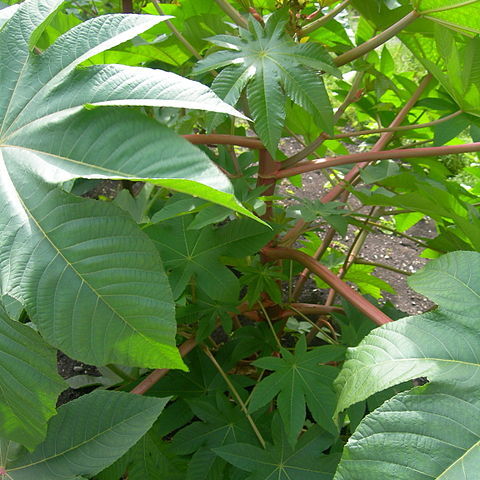Shrubs or trees (in tropical regions); twigs and foliage glabrous, sap watery. Leaves alternate, petiolate (petioles long, ? glanduliferous at apex), stipulate (stipules fused into a caducous sheath); blade peltate, palmately 7-11-lobed, ser-rate. Inflorescences terminal (sometimes appearing opposite the leaves or axillary due to sympodial growth), paniculate, the proximal nodes with cymules of several c flowers, the distal cymules 9 or I ; bracts papery, glandular at base; the flowers with valvate calyx, apetalous, disc absent. Staminate flowers pedicellate; calyx calyptrate in bud, splitting into 3-5 segments at anthesis; stamens co (up to 1000), the filaments partially connate into fascicles at base, irregularly branched; pollen grains spheroidal, tectate, 3-colporate, colpi narrow; pistillode absent. Pistillate flowers pedicellate, with calyx similar to the c; ovary of 3 carpels, muricate, the ovules 1 per locule, the styles connate below, bifid, the branches usually conspicu-ously papillate. Fruits capsular, echinate (or smooth in some cultivars), the columella wing-dilated above; seeds elliptic, somewhat compressed, smooth, mot-tled, carunculate, the endosperm copious, the cotyledons foliaceous and palmately veined.
Shrubs or small trees, evergreen, perennial, monoecious; stems and foliage without latex. Indumentum absent. Stipules ± entire, forming a conspicuous sheath, deciduous. Leaves alternate, petiolate, palmately lobed, penninerved, serrate, glands 2 at lamina base. Inflorescences terminal, paniculate, solitary, bisexual and usually androgynous with flowers in bracteate glomerules. Male flowers pedicellate; calyx lobes 3–5, valvate, unequal; petals absent; disc absent; stamens numerous and up to 1000, filaments haphazardly united to form a branched structure; anthers basifixed, bilobate, thecae oblong and longitudinally dehiscent; pistillodes absent. Female flowers pedicellate; calyx lobes 5, valvate; petals absent; disc absent; ovary 3-locular, ovules uniloculate; styles free or slightly connate at base, bifid. Fruit capsular, trilobate, surface echinate, dehiscing septicidally into 3 bivalved cocci. Seeds ovoid; testa crustaceous; albumen fleshy; caruncles entire, non-arilloid; cotyledons broad, flat.
Herbs [shrubs], annual or perennial, monoecious; hairs absent; latex absent. Leaves deciduous, alternate, simple; stipules present, caducous; petiole present, glands present at apex and usually proximally; blade palmately lobed, margins serrate, laminar glands present; venation palmate. Inflorescences bisexual (staminate flowers proximal, pistillate distal) or pistillate, terminal or leaf-opposed, racemelike thyrses; glands subtending each bract 2. Pedicels present. Staminate flowers: sepals 3–5, valvate, connate basally; petals 0; nectary absent; stamens to 1000, connate proximally in numerous slender, irregularly branched columns; pistillode absent. Pistillate flowers: sepals 5, distinct or connate basally; petals 0; nectary absent; pistil 3-carpellate; styles 3, distinct or slightly connate basally, 2-fid. Fruits capsules. Seeds ovoid or ovoid-ellipsoid; caruncle present. x = 10.
Annual herbs or herbaceous shrubs; indumentum absent; stems hollow. Leaves alternate; stipules united, deciduous, leaving circular scar around node; petiole long, apex with 2 glands, insertion peltate; leaf blade palmately lobed. Inflorescences terminal, branched or unbranched, bisexual; bracts broadly triangular, deciduous; male flowers proximal, female flowers distal. Male flowers: calyx 3-5-lobed, valvate, closed in bud; petals absent; disk absent; stamens very many; filaments united into ca. 25 phalanges; anthers 2-locular, subglobose. Female flowers: sepals 5, valvate, deciduous; petals absent; ovary 3-locular, softly spiny, sometimes tuberculate; styles 3, 2-lobed. Fruit a capsule, 3-locular, usually echinate. Seeds large, compressed-ovoid, smooth, marbled, carunculate.
Monoecious shrub or large herb; sap watery. Lvs alternate, stipulate, palmately lobed, serrate. ♂ and ♀ fls mixed in terminal panicles, often appearing axillary. ♂ fls: short-pedicellate; perianth herbaceous; segments 3-5, united in bud; filaments much-branched; anthers very numerous. ♀ fls: long-pedicellate; perianth membranous, soon deciduous; ovary 3-celled with a single ovule in each cell; styles 3, usually 2-fid. Fr. a 3-celled capsule; seeds smooth.
Male flowers: pedicels jointed, bibracteolate; buds globose; calyx membranous, closed at first, later splitting into 3–5 valvate lobes; petals absent; disk absent; stamens up to c. 1000, the filaments variously united, anthers basifixed, the cells subglobose, longitudinally dehiscent; pistillode absent.
Female flowers: pedicels considerably elongating in fruit; buds conical; sepals 5, valvate, soon caducous; petals absent; disk absent; ovary 3-celled, with 1 ovule per cell, echinate or smooth; styles 3, ± free or slightly connate at the base, bipartite, papillose-plumose, usually dark red.
Monoecious; stamens very numerous, with repeatedly branching filaments; styles 3, united at base, each bifid and plumose; capsule large, 3-lobed, covered with soft prickles; seeds 2, carunculate. Monospecific.
Inflorescences paniculate, leaf-opposed or subterminal, male in the lower half, female in the upper or rarely all female; bracts soon caducous.
Seeds dorsiventrally compressed-ovoid, smooth, usually marmorate, carunculate; testa crustaceous; albumen fleshy; cotyledons broad, flat.
Fruit 3-lobed, echinate or smooth, the spines accrescent, dehiscing into 3 bivalved cocci, leaving a prominent persistent columella.
Leaves alternate, petiolate, stipulate, peltate, palmately-lobed, the lobes glandular-serrate, penninerved.
Monoecious, glabrous annual or perennial herb or shrub, often tree-like.
Stipules united to form a caducous sheath.
Petioles glanduliferous at apex and base.

